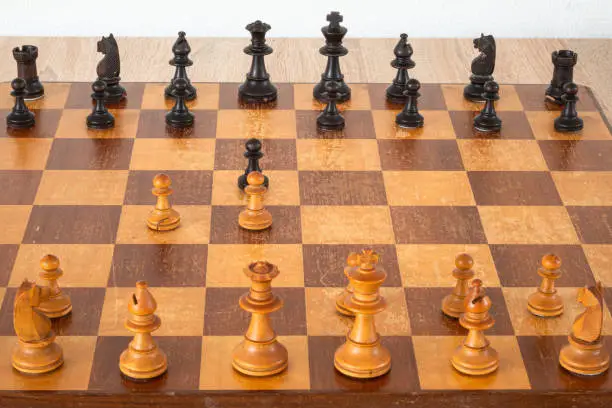What is the Best Opening Against the London System?
Contents
- 1 What is the Best Opening Against the London System?
- 2 Understanding the London System
- 3 Introducing the Old Indian Defense
- 4 Theoretical Aspects of the Old Indian Defense
- 5 Comparative Analysis with Other Openings
- 6 Sample Games and Model Positions
- 7 Practical Tips for Playing the Old Indian Defense
- 8 Addressing London System Player’s Resources
- 9 Adjusting to Opponent’s Responses
- 10 Common Challenges and How to Overcome Them
- 11 Conclusion
In the vast realm of chess strategy, one frequently encounters the London System, a formidable opening known for its flexibility and strategic depth. Choosing the right response to this system is crucial, akin to selecting the perfect tool for a job.
In this quest, the Old Indian Defense emerges as a fascinating and effective choice. Let’s embark on a journey to understand the London System, the significance of a strategic response, and why the Old Indian Defense stands out.

Understanding the London System
The London System is a popular chess opening characterized by the early development of the bishop to d3. This seemingly simple move aims to control the center and fortify the pawn structure. Its popularity among players of varying skill levels is attributed to its flexibility and ease of understanding. The London System can catch opponents off guard, setting the stage for a strategic advantage.
However, the need for an effective response becomes evident when we delve into the intricacies of the London System’s strategic nuances. Without a well-thought-out plan, players risk falling into subtle traps set by their London System-wielding opponents. Thus, the quest for the ideal opening gains significance.
Introducing the Old Indian Defense
In the world of chess openings, the Old Indian Defense is a strategic gem that diverges from the beaten path of the London System.
Much like the King’s Indian Defense, the Old Indian Defense intentionally slows down the development of the dark-squared bishop, finding its home on e7.
This deviation is not arbitrary; it’s a calculated move, and it holds significant advantages against the London System for a variety of reasons.

Delaying the Dark-Squared Bishop’s Development
One of the key features of the Old Indian Defense is the deliberate delay in developing the dark-squared bishop.
Unlike other openings that rush the bishop into action, the Old Indian Defense opts for a slower, more deliberate pace. This choice disrupts the conventional flow of the London System, forcing the opponent out of their comfort zone.
d4 d6 2. Nf3 Bg4
In this example, Black delays the development of the dark-squared bishop, focusing on establishing a solid pawn structure.
Utilizing the Pawn Structure to Control the Center
A significant strength of the Old Indian Defense lies in its pawn structure. By strategically positioning pawns, Black can exert influence over the center, creating a stable foundation for future maneuvers.
This not only provides stability but also offers a platform for launching counter-attacks.
d4 d6 2. Nf3 Nd7 3. e4 e5
Black chooses a pawn structure that controls the center, preparing for future strategic moves.
Strategic Reasons for Choosing the Old Indian Defense
Choosing the Old Indian Defense isn’t merely about breaking away from tradition; it’s a strategic decision rooted in disrupting the London System’s rhythm.
By embracing this defense, players gain the upper hand in steering the game towards positions that favor their strengths.
d4 d6 2. Nf3 Nd7 3. e4 Ngf6
In this position, Black opts for a strategic setup, delaying the development of key pieces for a more controlled approach.

Theoretical Aspects of the Old Indian Defense
To truly grasp the effectiveness of the Old Indian Defense, let’s delve into the theoretical aspects.
Analyzing key moves, common plans, and tactical motifs provides a comprehensive understanding of how this defense can be wielded as a powerful weapon against the London System.
d4 d6 2. Nf3 Bg4 3. c4 Nd7 4. Nc3 e5
In this position, Black follows the theoretical principles of the Old Indian Defense, focusing on piece development and controlling the center.
Comparative Analysis with Other Openings
While the Old Indian Defense is a compelling choice against the London System, it’s essential to compare it with other openings to make informed decisions based on playing style and preferences.
d4 d6 2. Nf3 Bg4 vs. 1. d4 d5 2. Bf4
Contrasting the Old Indian Defense with an alternative response like 2…d5 showcases the divergent strategies available against the London System.
Sample Games and Model Positions
Learning from the masters is a time-honored tradition in chess. Exploring notable games featuring the Old Indian Defense offers insights into strategic nuances, critical moments, and the development of model positions for aspiring players.
d4 d6 2. Nf3 Bg4 3. c4 Nd7 4. Nc3 e5 5. dxe5 dxe5 6. g3 c6 7. Bg2 Ngf6 8. O-O Be7 9. Qc2 O-O 10. Rd1 Qc7
In this game, Black successfully navigates the Old Indian Defense, achieving a solid position and ultimately securing the victory.
Practical Tips for Playing the Old Indian Defense
Strategic considerations during the game, tactical motifs to be aware of, and common mistakes to avoid – these practical tips equip players with the knowledge needed to confidently deploy the Old Indian Defense on the chessboard.
Practical Tip:
Consider delaying the dark-squared bishop’s development to disrupt the opponent’s plans and create a more controlled position.
Addressing London System Player’s Resources
While the Old Indian Defense offers a potent response, opponents employing the London System may throw surprises and deviations. Understanding these resources and learning how to navigate through them is essential for success.
d4 d6 2. Nf3 Bg4 3. e4
Recognizing and adapting to deviations, such as an early e4 by the opponent, is crucial for maintaining a solid defense.

Adjusting to Opponent’s Responses
Chess is a dynamic game, and opponents may deviate from typical lines. Strategies for handling various London System setups and adapting to opponent’s deviations ensure that players remain versatile and resilient.
Adaptation Strategy:
Be flexible in your approach, adjusting your strategy on your opponent’s moves and maintaining a dynamic mindset throughout the game.
Common Challenges and How to Overcome Them
No defense is foolproof, and challenges may arise. Recognizing common difficulties faced by players adopting the Old Indian Defense and providing tips for overcoming them ensures a well-rounded approach to this strategic choice.
Common Challenge:
Facing early pawn advances by the opponent can be challenging. Counter this by maintaining a solid pawn structure and looking for opportunities to break through.

Conclusion
In the intricate dance of chess openings, the Old Indian Defense emerges as a compelling answer to the London System. Its strategic depth, combined with the ability to disrupt the opponent’s plans, makes it a valuable addition to any player’s repertoire.
As you embark on your chess journey, remember that the best opening is not a one-size-fits-all concept. Experiment, adapt, and let the Old Indian Defense be your ally against the formidable London System. Happy playing!





